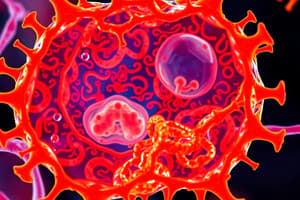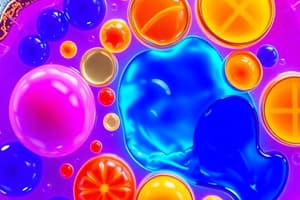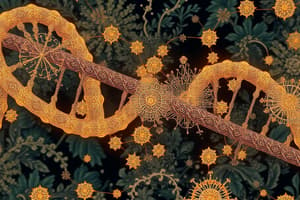Podcast
Questions and Answers
What is the role of the Golgi apparatus in a cell?
What is the role of the Golgi apparatus in a cell?
- It digests food and worn-out cell parts.
- It produces ribosomes.
- It modifies, sorts, and packages proteins. (correct)
- It captures energy from sunlight and uses it to produce glucose.
Which of the following is NOT a characteristic of prokaryotic cells?
Which of the following is NOT a characteristic of prokaryotic cells?
- They include bacteria.
- They are typically unicellular.
- They lack a nucleus.
- They have membrane-bound organelles. (correct)
What is the function of the cytoskeleton?
What is the function of the cytoskeleton?
- It produces energy for the cell.
- It provides structural support and helps with cell movement. (correct)
- It controls the entry and exit of materials from the cell.
- It stores food, water, and waste.
What type of feedback mechanism lowers or ends a response?
What type of feedback mechanism lowers or ends a response?
Which of the following is an example of passive transport across the cell membrane?
Which of the following is an example of passive transport across the cell membrane?
What is the process by which organisms maintain a relatively stable internal environment?
What is the process by which organisms maintain a relatively stable internal environment?
What is the difference between a solute and a solvent?
What is the difference between a solute and a solvent?
Which of the following is NOT a characteristic of a cell?
Which of the following is NOT a characteristic of a cell?
What is the process of cell division in which the nucleus divides?
What is the process of cell division in which the nucleus divides?
Which of the following correctly describes the process of diffusion?
Which of the following correctly describes the process of diffusion?
What is the function of a protein pump in a cell membrane?
What is the function of a protein pump in a cell membrane?
What is the longest phase of the cell cycle?
What is the longest phase of the cell cycle?
Which of the following is a characteristic of a eukaryotic cell cycle?
Which of the following is a characteristic of a eukaryotic cell cycle?
What is the main difference between mitosis and meiosis?
What is the main difference between mitosis and meiosis?
Which of the following is NOT a characteristic of a totipotent cell?
Which of the following is NOT a characteristic of a totipotent cell?
Which of the following is NOT a function of the cell membrane?
Which of the following is NOT a function of the cell membrane?
Flashcards
Cell
Cell
The basic unit of structure and function in living things.
Unicellular Organism
Unicellular Organism
An organism made of one cell that lacks a nucleus, e.g., bacteria.
Multicellular Organism
Multicellular Organism
Organisms made up of more than one cell, e.g., plants and animals.
Asexual Reproduction
Asexual Reproduction
Signup and view all the flashcards
Organelle
Organelle
Signup and view all the flashcards
Cell Membrane
Cell Membrane
Signup and view all the flashcards
Diffusion
Diffusion
Signup and view all the flashcards
Osmosis
Osmosis
Signup and view all the flashcards
Hypertonic Solution
Hypertonic Solution
Signup and view all the flashcards
Hypotonic Solution
Hypotonic Solution
Signup and view all the flashcards
Isotonic Solution
Isotonic Solution
Signup and view all the flashcards
Endocytosis
Endocytosis
Signup and view all the flashcards
Mitosis
Mitosis
Signup and view all the flashcards
Stem Cell
Stem Cell
Signup and view all the flashcards
Study Notes
Cell Structure and Function
- Cell: Basic unit of structure and function in living things
- Multicellular Organisms: Composed of more than one cell
- Unicellular Organism: Single-celled organism (e.g., bacteria)
- Prokaryotic Cell: Lacks a nucleus and membrane-bound organelles (e.g., bacteria)
- Eukaryotic Cell: Contains a nucleus and membrane-bound organelles (e.g., plant & animal cells)
- Asexual Reproduction: Single-celled organisms reproduce by dividing into two identical cells
- Organelle: Specialized structure performing specific functions within a cell
- Cell Membrane: Controls entry and exit of substances
- Cytoskeleton: Network of protein filaments maintaining cell shape and movement
- Cytoplasm: Jelly-like fluid suspending organelles
- Nucleolus: Structure inside the nucleus producing ribosomes
- Endoplasmic Reticulum (Rough ER): Modifies, finishes, and transports proteins
- Endoplasmic Reticulum (Smooth ER): Modifies, finishes, and transports lipids
- Golgi Apparatus: Modifies, sorts, and packages proteins
- Lysosome: Breaks down food and worn-out cell parts
- Vacuole: Stores food, water, wastes, and other materials
- Centrioles: Appear during cell division; help separate chromosomes
- Cilia/Flagella: Hairlike structures assisting in movement
- Mitochondria: Site of cellular respiration, producing ATP energy
- Chloroplast: Captures sunlight to produce glucose (photosynthesis)
- Cell Wall: Rigid carbohydrate layer surrounding plant cells
- Homeostasis: Maintaining a stable internal environment
- Equilibrium: Balance between continuing processes
- Stimulus: Signal triggering a response
- Positive Feedback: Enhances response
- Negative Feedback: Lowers or stops response
Cell Membrane and Transport
- Selective Permeability: Cell membrane allows some substances to pass while blocking others
- Concentration Gradient: Difference in concentration of a substance between locations
- Passive Transport: Movement of substances across the membrane down the concentration gradient without energy
- Diffusion: Movement of a substance from high to low concentration
- Facilitated Diffusion: Diffusion through a protein channel
- Osmosis: Diffusion of water across a membrane
- Active Transport: Movement of substances against the concentration gradient using energy
- Protein Pumps: Use energy to transport charged atoms or large particles
- Endocytosis: Cell membrane engulfs material to create a vesicle (entering cell)
- Exocytosis: Vesicle releases contents outside the cell (exiting cell)
Cell Reproduction and Development
- Fertilization: Fusion of egg and sperm to create a new organism
- Mitosis: Cell division where the nucleus divides
- Cell Differentiation: Cells become specialized in structure and function
- Stem Cell: Unspecialized cell able to develop into any cell type
- Tissue: Group of similar cells performing the same function
- Organ: Group of tissues working together
- Organ System: Group of organs working together
- Cell Cycle: Repeated pattern of growth, DNA replication, and cell division
- Interphase: Longest phase of the cell cycle
- Prophase: Chromosomes become visible, nuclear envelope dissolves, spindle forms
- Metaphase: Chromosomes line up in the middle of the cell
- Anaphase: Chromosomes move to opposite sides of the cell
- Telophase: Nuclei reform and the cell begins to split
- Cytokinesis: Division of the cytoplasm
- Chromosome: Thread-like structure of DNA containing genes
- Chromatid: One of two identical sister parts of a duplicated chromosome
- Centromere: Region connecting sister chromatids
- Cancer: Uncontrolled cell division leading to tumors
Studying That Suits You
Use AI to generate personalized quizzes and flashcards to suit your learning preferences.




